
The Volvo 760, the first totally new ‘Ovlov’ in years, came on the scene in the early ’80s to replace the then-current top of the line sedan, the 264 GLE. While the 760 GLE and its less expensive sibling the 740 were meant to replace the 240/260 series, both would be built concurrently for several years. Accounting for all redesigns and name changes, this car lasted all the way to 1998, as the straight six-powered S90/V90.
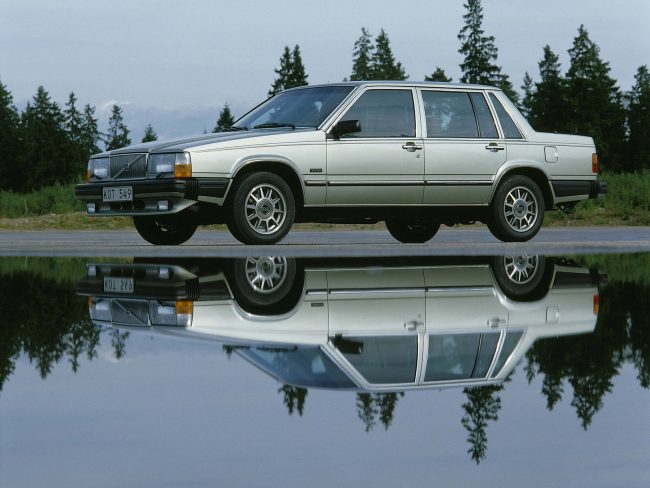
1982 760 GLE
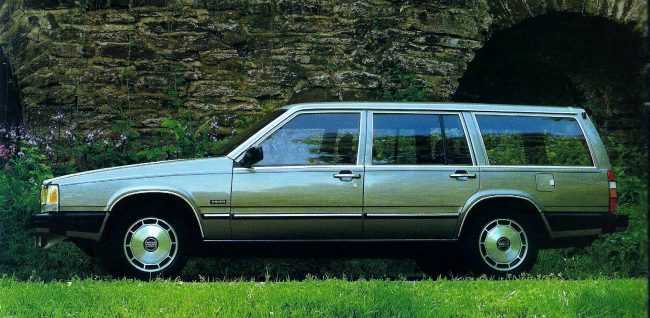
The 760 had a unitized body and was powered by the 2.8L B28 PRV V6, a joint-venture engine used by Peugeot, Renault and Volvo, not to mention the star-crossed DeLorean. It produced 130 hp @ 5500 rpm and 153 lb-ft of torque. It was not a particularly sturdy engine. In 1984, the 760 Turbo was introduced. Instead of the V6, it had the turbocharged and intercooled B230FT ‘redblock’ engine-a most robust powerplant-producing 160 hp @ 2900 rpm and 187 lb-ft.

With this new turbo four, the 760 Turbo was a pretty speedy car in its day. Contrary to Volvo’s usual practice of the second digit of the model name corresponding to the number of cylinders, the 760 Turbo had an inline four-cylinder. Other than more exterior chrome, different alloy wheels and a fancier interior with automatic climate control, it was much like the 740 Turbo, also introduced in 1984.

In 1986, wagons were added to the 740 and 760 line, and that included a 760 Turbo and 740 Turbo wagon. By 1986, standard features on the boosted 760s included an electric sunroof, AM/FM stereo cassette with a five-band graphic equalizer and heated seats. 760s also had a unique Nivomat automatic leveling system. These cars were fully loaded right off the assembly line; you really didn’t need to add anything.

I found this gray 760 Turbo in Coralville, IA about eight years ago, while visiting the University of Iowa Hospitals and Clinics. It looked to be in fair shape. This particular car has the 1986-89 740 Turbo alloy wheels, as the 760s used a more flat style of wheel with a wide chrome center cap, as seen in the brochure pictures of the dark blue sedan and light green wagon.
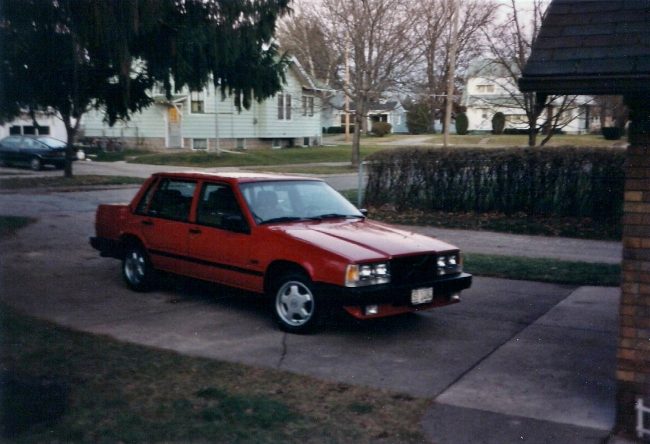
It reminded me of the ’88 740 Turbo my dad had. Probably my favorite car that he owned. It was special-ordered at Lundahl Volvo in Moline in bright red with tan leather and the accessory wood dash and door panel trim. It was the first car we had with an airbag. Dad traded in a silver ’84 240 GL sedan (previously discussed here on RG) for this car, and needless to say it was a lot faster. The alloys on these 740 Turbos are my favorite style of Volvo wheel.
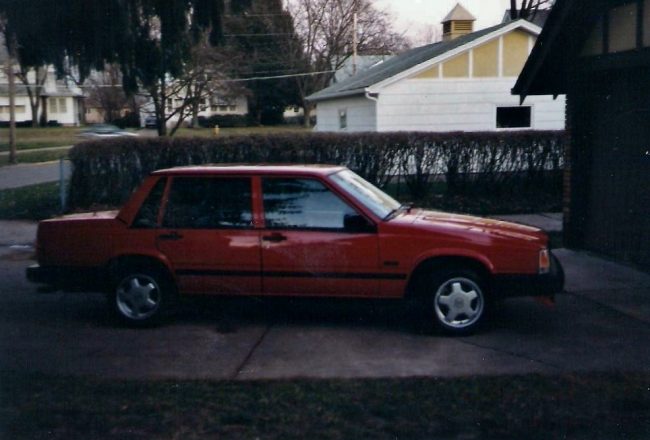
I remember this car well, as Dad took me to school in it every morning between 2nd and 5th grades. It was boxy but sharp, and I loved the color. It was hard for him to balance his morning coffee in the years before cupholders, though.
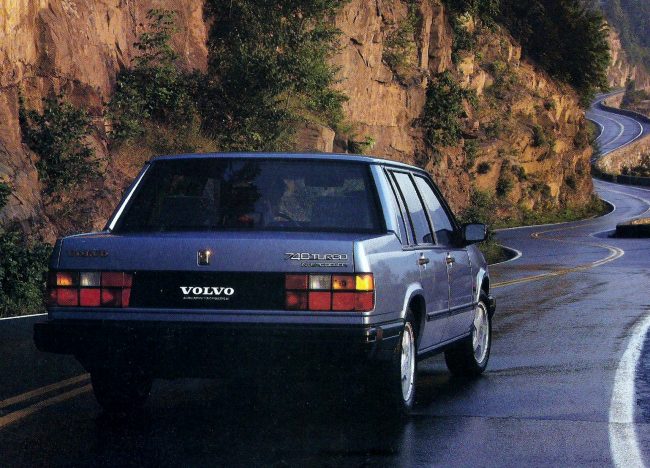
The 740 Turbo lasted in this form through 1989, while the 760 lasted through ’87. In 1988 the 760 GLE and Turbo received a new nose and instrument panel, and the last ones were built in 1990. These were solid, well built cars, and I really liked them. Dudley Moore probably said it best in Crazy People: “They’re boxy but they’re good.”
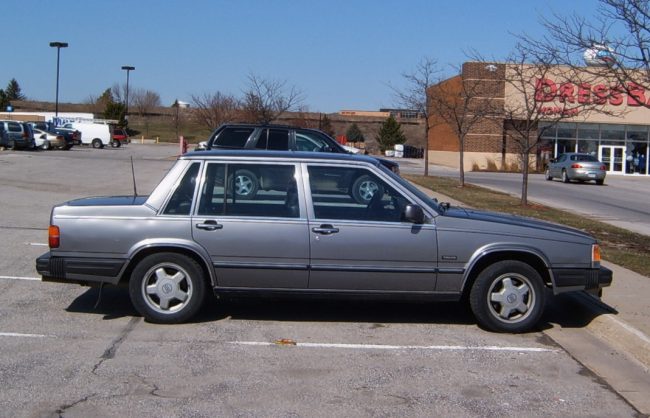







10 Comments
I thought it was ‘They’re boxy, but they’re safe!’
Still, they were nice looking sedans, and yes, the turbo ones were a lot faster than -anybody- expected. Surprising a lot of people on the road.
“Buy Volvos. They’re boxy but they’re good. We know they’re not sexy. This is not a smart time to be sexy anyway, with so many new diseases around. Be safe instead of sexy. Volvo – Boxy but good.” — Crazy People, 1990
In this period the upper middle class euros were really being held back by their engines. Lousy 90 degree V6s from Volvo, Peugeot, and Rover and rough turbo inline fours and fives from Peugeot, Saab, Audi, Rover, and Volvo.
Even The American Europeans were no inspiration as Ford’s 2.9 Cologne V6 was weak and aging and Opel’s 54 degree V6 was just terrible.
There was talk that the PRV V6 was originally to be a V8 before the oil shock. A small 3.5ish OHC V8 would have really been interesting in PRVs like this 760 (780?) and Deloreans for that matter.
The problem with those engines is they only sold them in any kind of volume on the US export models, because in the home markets they were mostly equipped with diesels (especially the Peugeot), or some sort of sub 2-liter 4 cylinder gasoline, mated to a manual gearbox. With fuel prices double or more US prices, lower incomes, and higher taxes not many in Europe could afford a V-6 gasoline engine or turbo or automatic transmissions or A/C or power windows or even power steering, which is why all those “fancy” features for the American versions were often not very well developed or reliable. Volvo probably adapted better to the US than any other near luxury Euro brand, probably because the Swedish home market was too small to rely on.
From hundreds of hours of “CarTalk” I remember that these cars have truly epic heater core repairs if (when?) they start leaking, but otherwise the 4-cylinders are bulletproof.
I once drove a 940 my college professor owned. Leather, loaded. Definitely had a feel unlike any car I’ve driven before or since.
Safe in the lips of a Vulva.
My wife has one, a 86 760 Turbo, when we first met. It was a good and solid car but the turbo was failing and the head gasket went right after we got married in 2010. I did enjoy the surefootedness on Michelin snow tires and the 80s Euro vibe.
Due to limited funds, at the time, we replaced it with a 1998 Acura 3.2TL (longitudinal V6) that was well cared for (yes John, I considered a couple GM cars). Sometimes I wish I’d have kept the 760 and dropped in a V8…gave it to the local Volvo shop, who helped me find that Acura.
Now my wife drives a GX460 and it reminds me a bit of the good aspects of that Volvo: rugged construction, not attractive, tall with lots of glass, stout motor, and should go on for a long long time. However, I can’t get comfortable with the badge.
Our 2012 Accord still does quite well, I guess the used Acura pushed me that direction. That and a wider backseat (for 2 car seats, at the time) than the Malibu. Now those kids in the car seat will take over driving it in a few years.
Rover would have been very pleased with the 3.2 if not the transmission it came with, instead of the earlier 2.5 version they got in the earlier 825 version for the Honda joint venture Rover Sterling/Legend. Originally Honda was only going to make it 3 valve per cylinder as per their 80s custom. The V6 was Honda’s responsibility and Rover also lobbied for the displacement bump to 2.7. Still not satisfied, and their buyers were coming from the V8 RWD SD1, they decided on a line of proprietary Tickford Turbos. The later TL was more comparable to the early Legend/Sterling in size than how big Legends became later and the 3.2 moved it well.
My wife had a 98 V90 and one thing nobody mentions about them but to my taste it had the best steering I have experienced. Later RWD Jaguars I had wern’t close to as good nor my current 2018 V90. I know Texn a Chinese plot, but the 18s is better that the really bad steering early 2000s Volvo’s had. Maybe those were Mitsubishi?
Interesting history on Honda’s early V6 motor. We did consider an S90 also, but too many potential issues with the models found locally. The new Volvo’s drive well, Ford was not good to them.
Our 98 V90 drove quite well but was hardly trouble free, poor rear hatch fit, annual A/C troubles and some hesitation/electrical issues. The S90 came with much more aggressive tires and I would have wanted to try the effect on ride before pulling that trigger,
I knew a girl who was sent off to UVA with a hand me down 760 GLE Turbo. The first engine blew well past warranty, but before one might reasonably expect an engine made outside of England or Italy to do so. At the time, the engine swap I was most familiar with was buying M50s and putting them into E30s. The E36s had only been in production two or three years, but they were getting written off in impressive numbers by enthusiasts who’d been impressed enough to finally let go of their 2002s.
I knew about what a used M50 cost, often bundled with its ECU and transmission. Getting a running used Volvo turbo four involved a national search and three times as much money. That’s how you can tell whether or not an engine is actually any good. You can buy 2nd generation Prius engines for little more than scrap. Naturally aspirated Honda engines are only a little more. Jeep 4.7s or Triton 5.4s? They’re golden hen’s teeth, because five of them blow for every Grand Cherokee of F150 that gets wrecked. Those turbo Volvo engines were the same, and I have no idea why they have a good reputation.
An ex-girl-friend of mine had a 940(16V NA engine) that I had a grudging respect for. I didn’t like anything about driving it, but she abused it for over two hundred thousand miles before it received some light body damage that wasn’t worth fixing. Her Volvo love ended with the 2001 V70 XC that replaced it. The one that was making a noise that I thought was the bevel gear, but that the Volvo dealer told her was undercarriage rust that wasn’t economical to repair in 2006. Had she been the original owner, I think there would have been a warranty issue. She says there wasn’t one, but I wasn’t involved in what happened. Ironically, I was by then dating the daughter of a guy who ran a local Volvo dealer and national Volvo parts business.